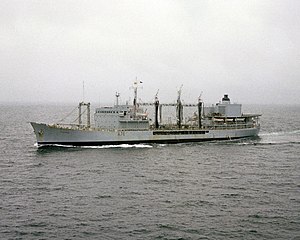 RFA Tidepool (A76) underway
| |
| Class overview | |
|---|---|
| Name | Tide class |
| Operators | |
| Preceded by | RFA Olna |
| Succeeded by | Ol class |
| Built | 1953–1963 |
| In commission | 1955–1992 |
| Planned | 4 + 2 |
| Completed | 6 |
| Retired | 6 |
| General characteristics | |
| Type | Replenishment oiler |
| Displacement |
|
| Length | 583 ft (178 m) |
| Beam | 71 ft (22 m) |
| Draught | 32 ft (9.8 m) |
| Propulsion |
|
| Speed | 17 knots (20 mph; 31 km/h) |
| Complement | 90 (RFA) |
The Tide class was a series of six replenishment oilers used by the Royal Fleet Auxiliary (RFA), the naval auxiliary fleet of the United Kingdom, the Royal Australian Navy (RAN), and the Chilean Navy.
The class was based on RFA Olna, which had served with the British Pacific Fleet during the Second World War.[1] Three ships were laid down for the RFA in 1953, with a fourth being ordered by the RAN at the same time.[1] Two more ships, built for the RFA to a modified design, were launched in 1962.
Upon completion, the RANs Tide Austral could not be accepted into service because of manpower and financial difficulties. The ship was instead loaned to the RFA from 1955 until 1962, when she was returned to the RAN and commissioned as HMAS Supply. She was 'paid off' in 1985.[1]
The first three ships were removed from service and scrapped during the late 1970s. The two modified ships, Tidespring and Tidepool saw service in the Falklands War, after which Tidepool was sold to the Chilean Navy and renamed Almirante Jorge Montt.[2] Tidespring remained with the RFA and was scrapped in 1992. Supply remained with the RAN until 1985.